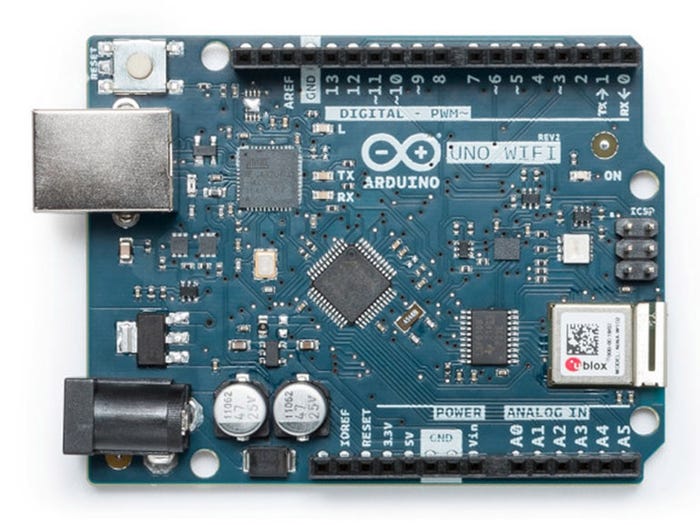Arduino IoT Product Line Expands with Two New Boards
New Arduino IoT offerings launched for the recent Bay Area Maker Faire could help to democratize prototyping of smart connected devices further. Two execs at the company explain.
May 21, 2018

Before 2003, when the open source hardware and software firm Arduino was born, prototyping with electronics was not for the faint of heart. Having a background in electronics engineering and programming was indispensable, and the requisite hardware tended to be expensive.
Along came Arduino, with an aim to change the status quo. With roots in the now-defunct Interaction Design Institute Ivrea (IDII) in northern Italy, Arduino helped accelerate the so-called “Maker” movement.
Two executives at Arduino, CEO Fabio Violante, and Massimo Banzi, co-founder and chief technology officer recently sat down with IoT Institute to discuss its new hardware. There’s the MKR Vidor 4000, the first Arduino based on an FPGA chip. “We’re extremely excited about this product because it adds another level of flexibility to people,” Violante said. According to Hackaday, the addition of
“FPGA to the Arduino ecosystem is on the list of the most interesting advances in DIY electronics in recent memory.”
And then there’s the Uno WiFi Rev 2, an IoT board with an enhanced AVR microcontroller from Microchip, which also joined the Arduino IoT product line. In the following Q&A, Violante and Banzi explain why they are excited about the new hardware, Arduino’s initiative to make its hardware secure by design and its work to expand its educational activities.

I understand Arduino is seeing more business users deploying Arduino for prototyping and production-scale IoT projects. Can you tell me more about that?
Banzi: Arduino continues to be very popular in the prototyping space. We released our first product with connectivity back in 2007.
After that, we’ve seen more and more people use Arduino boards for small production runs. We see this at small- to medium-sized companies, as well as big Fortune 500 companies. If somebody has a specific problem, they can build a device that addresses it. We are seeing this trend pick up as we expand the number of IoT products we offer. We have a full product line that includes basically every single type of connectivity, including narrowband IoT.
Can you summarize what Arduino is also doing to increase the flexibility of your hardware for IoT applications?
Banzi: We started to develop the idea for the MKR family of products of putting shields on top of them. By combining a few different boards and assembling them, you can solve a ton of different problems.
For example, we released a shield that allows you to talk to RS485, Modbus networks, CANopen and other protocols.
So one of the things we are seeing is that people take all these different modules and assemble them.
One of the things we keep saying is that the best way to understand what IoT can do for you is to actually do it.
There’s also a lot of code available online for Arduino to basically speak any protocol you can imagine.
People can build a working solution very quickly, and now they’ve worked on the sort of hardware side but are also working on the different layers of cloud connectivity.
Throughout this year and going into the next year, we will progressively release more and more parts to this IoT cloud to the point that there will be a full IoT application development platform. You start with the devices in the field, and you go all the way up to the UI that people use to interact with those devices.
How do you see Arduino driving adoption of IoT in enterprise and industrial applications?
Violante: There is still sometimes a gap in expectations from analysts and reality of people. But we have seen a lot of people working on IoT in the last couple of years, and we have seen how IoT can be transformational for many businesses.
We’ve got people making, for example, a connected oven that changed a company’s business model. IoT is becoming real, and it is becoming more accessible in terms of price point for a single chip.
There is still a conundrum regarding the complexity involved in an IoT project. Not all the companies can afford to maintain an array of competencies needed to go from embedded hardware up to the cloud stack and the analytics, and understand the numbers and so on and so forth.
There is still work to be done to help make IoT transformation more real for ordinary people who don’t have the resources to buy a one year project from a systems integrator.
Our efforts include not just the hardware side but extend to the cloud. You will see more and more announcements in the upcoming months that are based on, of course, the open source idea of having protocols that can be leveraged by people without the fear the protocol they are using will become obsolete.
Banzi: One of the things we keep saying is that the best way to understand what IoT can do for you is to actually do it. With Arduino, you can put your hands on the hardware. And there is a ton of existing code.
We’re not positioning Arduino as a means to take your current industrial equipment and throw it away. But there’s a ton of situations with people whom we speak to where they have an existing system that works, and they want to connect that system to a more extensive network. They want to take that data out of the system and bring it to a place where they can understand it, analyze it and where they can respond to alerts.
Applications like this are where Arduino is being used a lot.
What is Arduino’s position on helping people with cybersecurity?
Banzi: We want to create a system where there is security by default.
You see a lot of examples on the internet of people that connect to the cloud and, you know, just have a password or maybe not even a password — just an API key. That makes the whole thing very insecure.
So we’re trying to embed a crypto chip everywhere, and we’re developing code that allows people to take advantage of it. But the ultimate goal is that the security will come out of the box. I think that’s very important. This is part of the culture of explaining to people how to do IoT properly — with secure authentication. In a lot of code examples that you find on the Internet that people use to start off their projects from, it seems like security is left as an exercise to the user. That is obviously a very dangerous position.
What’s new with your WiFi Rev 2 board?
Banzi: There was an Arduino Uno Wi-Fi a while ago, which was based on an ESP8266 Wi-Fi chip along with a classic ATmega328P, which is the one that you find on the classic Arduino Uno.
But that product had a number of issues — one of them was that the main processor didn’t have enough computing power and memory to be able to handle real IoT applications.
So we worked with Microchip and adopted their latest processor, ATmega4809, which has a lot more flash and a lot more RAM. That is very important when you’re building IoT applications.

And then we couple that with this NINA module from u-blox, which we are adopting across the board.
We wrote the firmware ourselves, and it’s open source so you know if you find a bug or the community finds a bug, we can fix it immediately.
A lot of other Wi-Fi modules are closed source, and if there is a bug, you’re stuck until somebody from the vendor fixes it.
What other features does WiFi Rev 2 have?
Banzi: We added a crypto chip as, well. We added the latest version instead of the ATECC508 we use the ATECC608A. It has a few more features, but it’s largely the same thing.
And the general idea is with more RAM and flash you can start writing functioning IoT applications even with an 8-bit microcontroller.
We added a 6-axis IMU. It has an accelerometer and a gyroscope, so the board itself can become a sensor.
So technically somebody could take this board and mount it on a piece of equipment that vibrates and, with no extra hardware, you would have an element that can detect vibrations and can communicate with the cloud.
The firmware that we are developing for the NINA [Bluetooth low energy] modules will allow people to connect the devices to our cloud.
We have an IoT cloud that allows people to connect devices to it.
In addition, all of these devices that have their NINA module will also be connected to that network, as well.
It is still compatible with all of the Arduino UNO software, but it’s got a proper connectivity and security infrastructure and can talk to our cloud. So I think it’s a big improvement.
Arduino has long had an educational focus. What are your plans to help people continue to learn about hardware and programming?
Violante: So as far as the education angle is concerned, this is a big part of our legacy. Probably most of the schools in the world are using Arduino. In the past basically, we have educators that picked up the Arduinos themselves, which they used for their projects and for their teaching and so on and so forth.
Since I joined Arduino, I have been working with Massimo [Banzi] and [David Cuartielles], CTO of Arduino Education on education. We created an entire division that not only develops boards for teachers, but we also started creating a structured program for different grades of education.
The first and probably the most popular course on this program is called CTC: Creative Technologies for the Classroom. It is based on a bundle of hardware components to do classroom experiments. It has an e-learning platform and a ton of content and examples and exercises that teachers can use not only to teach but also learn how to teach Arduino with a project-centric approach: having people put their hands on projects and getting to learn the technology.
This program has been very popular so far in Spain and in America. We had more than 17,000 students already being trained using this program by their respective schools. The exciting thing is that, for example, in Spain, they did it at the city level sponsored by private foundations. The students, at the end of their academic year, do a sort of a Maker Faire[-type project] and in the last edition, we had like 4000 students showing their project.
The other thing is that we have worked on for two years together with Mathworks on this engineering kit because a lot of universities were using Arduino. We co-developed with Mathworks this kit that is called the Arduino Engineering Kit that is now available. This engineering kit is basically project based. It has the combination of the Arduino MKR board.
We use the Wi-Fi board in that kit. There is a sophisticated remote control board as well that we provide. The IMU enables people to do multiple experiments.
There are three projects that people can do. One is fascinating. It’s the self-balancing motorcycle that people can program using Mathworks. The other one is a forklift, and the third is a drawing robot. We also include in the box a license for Mathworks tools for a for one year.
It’s exciting to see how professors at universities are responding to this project. We started selling this product preorders and, a few days ago, we already have hundreds of people that bought the product. So we are filling a gap. We will continue investing in this type of partnerships moving forward — continuing the legacy of education.
About the Author
You May Also Like






